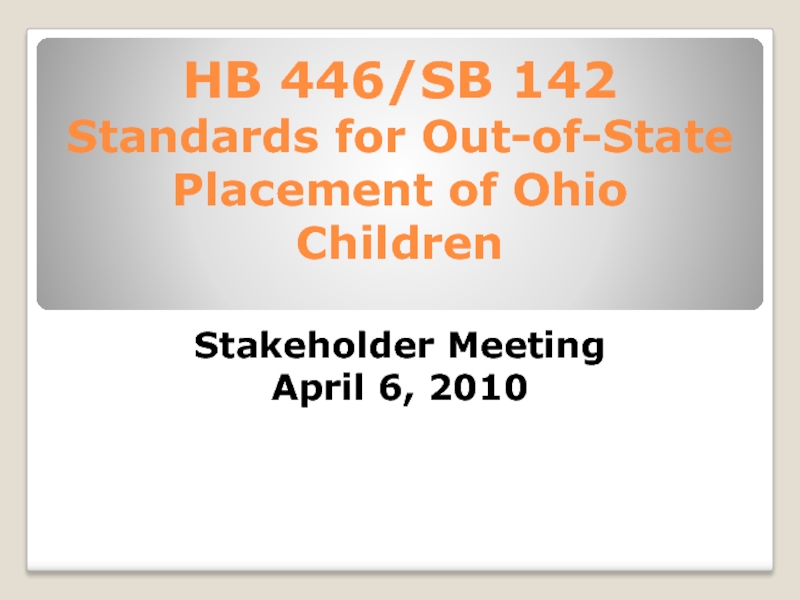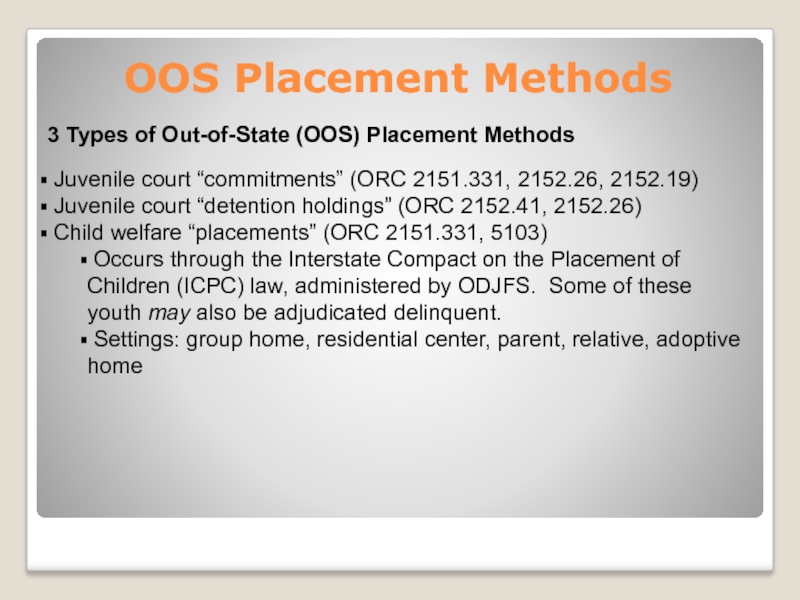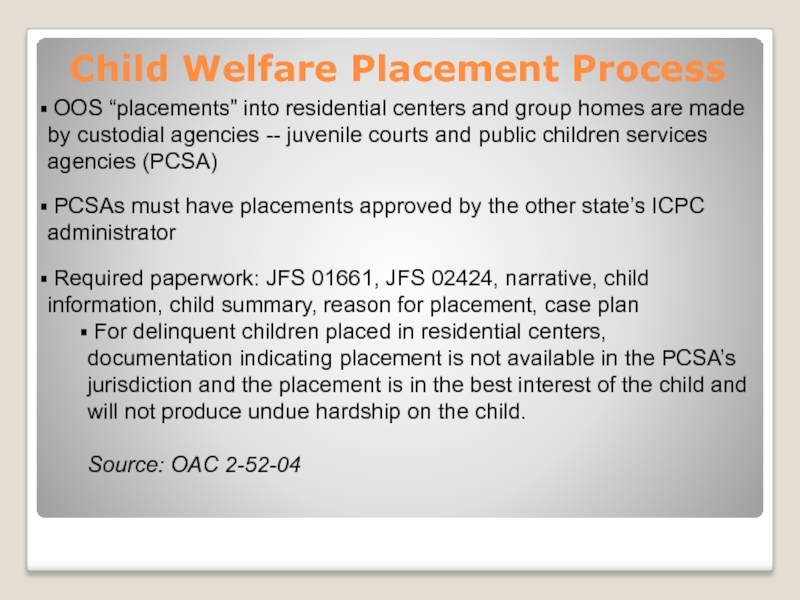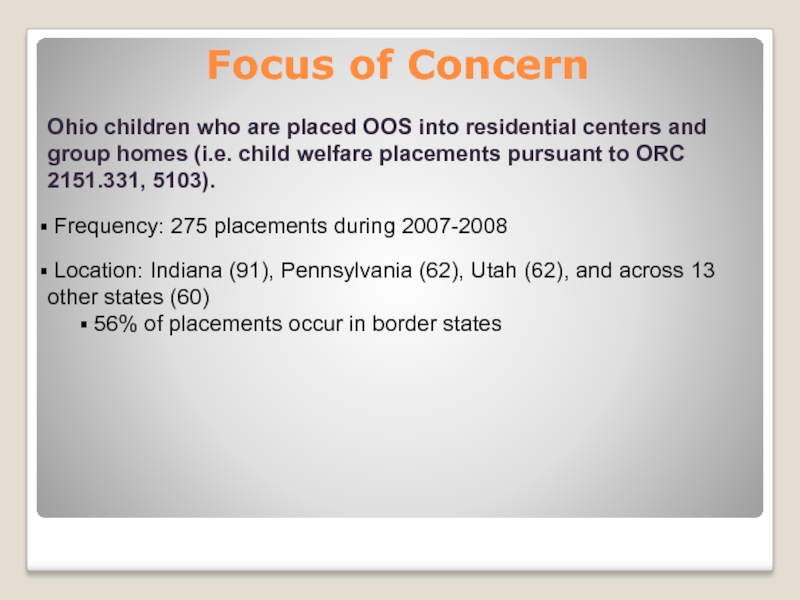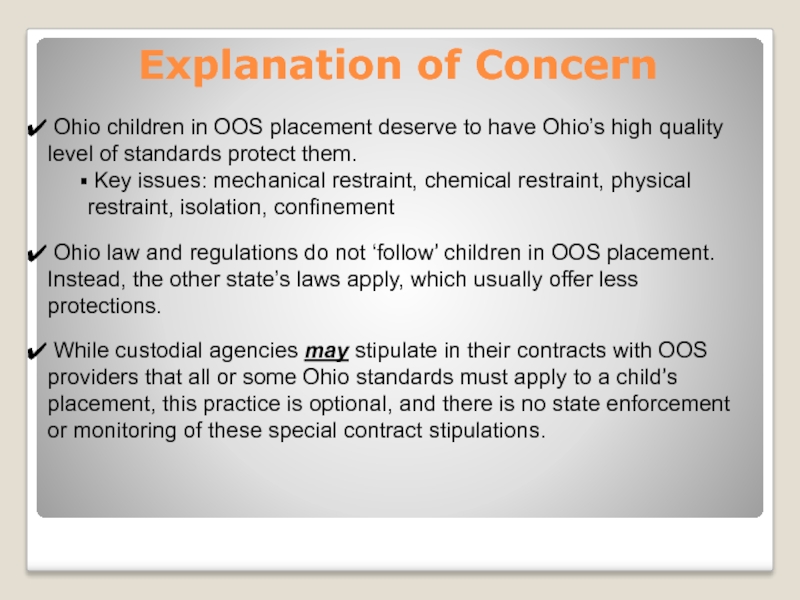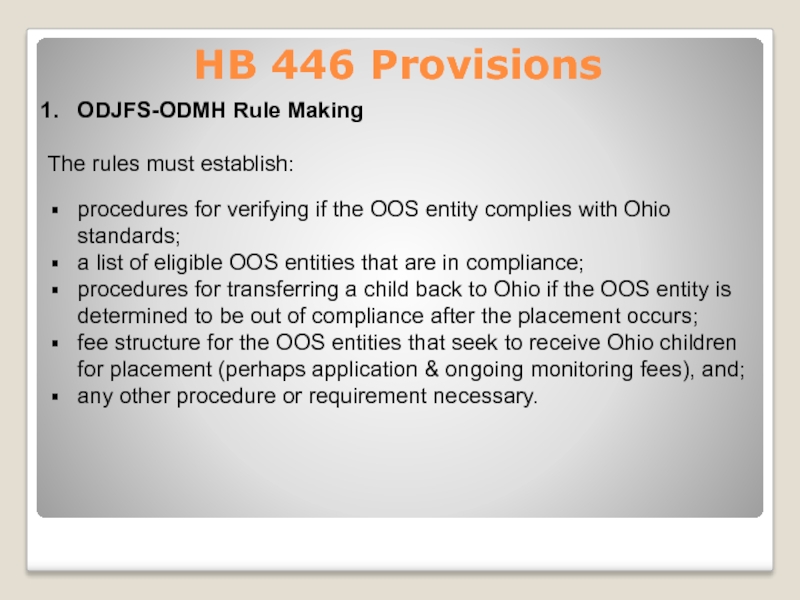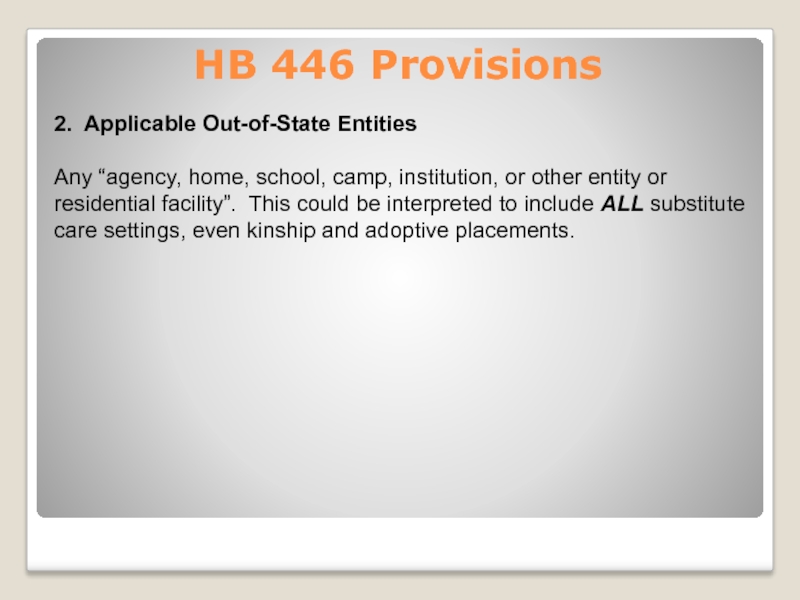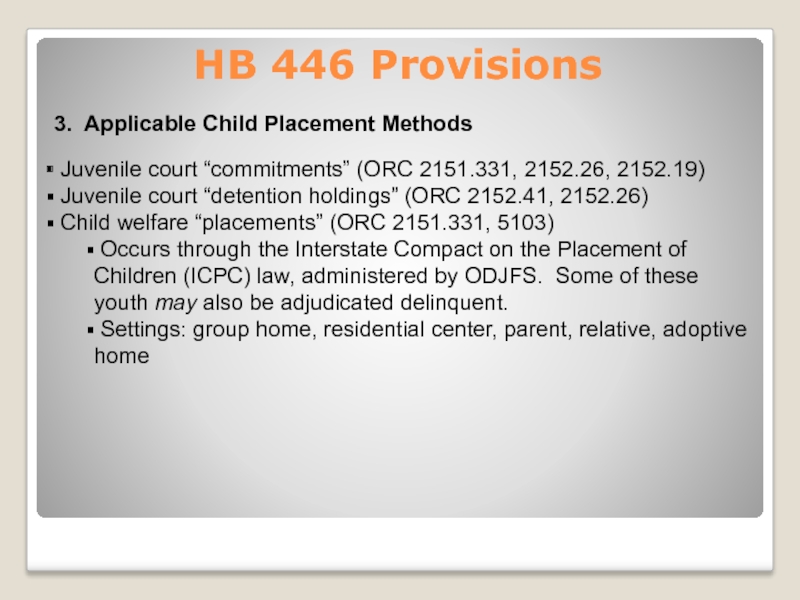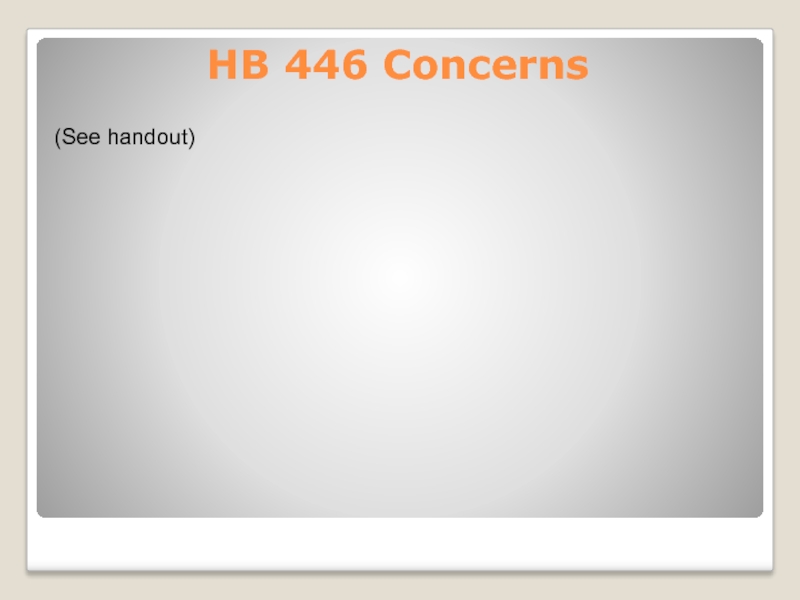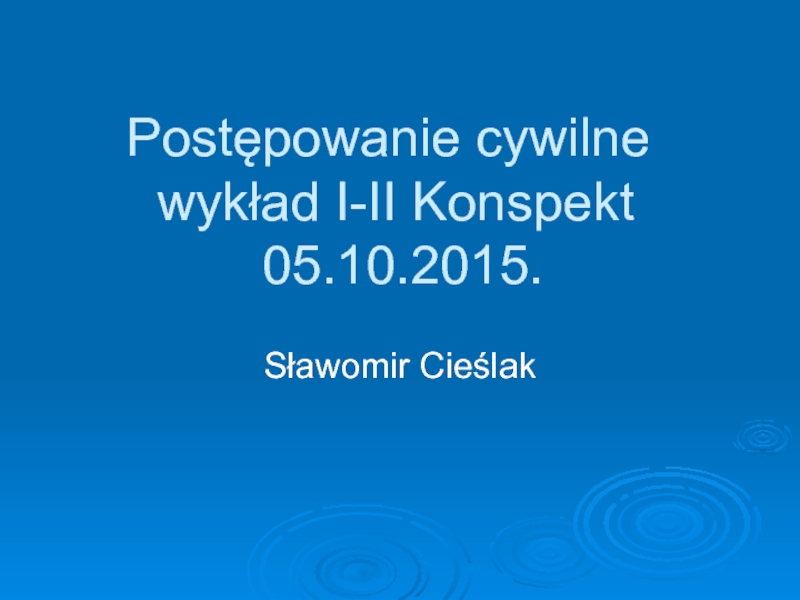2010
- Главная
- Разное
- Дизайн
- Бизнес и предпринимательство
- Аналитика
- Образование
- Развлечения
- Красота и здоровье
- Финансы
- Государство
- Путешествия
- Спорт
- Недвижимость
- Армия
- Графика
- Культурология
- Еда и кулинария
- Лингвистика
- Английский язык
- Астрономия
- Алгебра
- Биология
- География
- Детские презентации
- Информатика
- История
- Литература
- Маркетинг
- Математика
- Медицина
- Менеджмент
- Музыка
- МХК
- Немецкий язык
- ОБЖ
- Обществознание
- Окружающий мир
- Педагогика
- Русский язык
- Технология
- Физика
- Философия
- Химия
- Шаблоны, картинки для презентаций
- Экология
- Экономика
- Юриспруденция
Standards for Out-of-State Placement of Ohio Children Stakeholder Meeting презентация
Содержание
- 1. Standards for Out-of-State Placement of Ohio Children Stakeholder Meeting
- 2. OOS Placement Methods 3 Types of
- 3. Child Welfare Placement Process OOS
- 4. Child Welfare Placement Monitoring Requirements for the
- 5. Focus of Concern Ohio children
- 6. Explanation of Concern Ohio
- 7. Purpose of HB 446 Ensure
- 8. HB 446 Provisions ODJFS-ODMH Rule Making
- 9. HB 446 Provisions 2. Applicable Out-of-State Entities
- 10. HB 446 Provisions 3. Applicable Child Placement
- 11. Other States CT, TX, GA,
- 12. HB 446 Concerns (See handout)
Слайд 1HB 446/SB 142 Standards for Out-of-State Placement of Ohio Children Stakeholder Meeting April 6,
Слайд 2OOS Placement Methods
3 Types of Out-of-State (OOS) Placement Methods
Juvenile court
“commitments” (ORC 2151.331, 2152.26, 2152.19)
Juvenile court “detention holdings” (ORC 2152.41, 2152.26)
Child welfare “placements” (ORC 2151.331, 5103)
Occurs through the Interstate Compact on the Placement of Children (ICPC) law, administered by ODJFS. Some of these youth may also be adjudicated delinquent.
Settings: group home, residential center, parent, relative, adoptive home
Juvenile court “detention holdings” (ORC 2152.41, 2152.26)
Child welfare “placements” (ORC 2151.331, 5103)
Occurs through the Interstate Compact on the Placement of Children (ICPC) law, administered by ODJFS. Some of these youth may also be adjudicated delinquent.
Settings: group home, residential center, parent, relative, adoptive home
Слайд 3Child Welfare Placement Process
OOS “placements” into residential centers and group
homes are made by custodial agencies -- juvenile courts and public children services agencies (PCSA)
PCSAs must have placements approved by the other state’s ICPC administrator
Required paperwork: JFS 01661, JFS 02424, narrative, child information, child summary, reason for placement, case plan
For delinquent children placed in residential centers, documentation indicating placement is not available in the PCSA’s jurisdiction and the placement is in the best interest of the child and will not produce undue hardship on the child.
Source: OAC 2-52-04
PCSAs must have placements approved by the other state’s ICPC administrator
Required paperwork: JFS 01661, JFS 02424, narrative, child information, child summary, reason for placement, case plan
For delinquent children placed in residential centers, documentation indicating placement is not available in the PCSA’s jurisdiction and the placement is in the best interest of the child and will not produce undue hardship on the child.
Source: OAC 2-52-04
Слайд 4Child Welfare Placement Monitoring
Requirements for the Ohio sending agency:
Case planning
Semiannual administrative reviews
Visitation
Request an OOS agency to provide supervision and services and submit written supervisory reports monthly
Contact the placement setting within 10 days of placement and at least every other month thereafter
Conduct monthly face-to-face visits with the child within the substitute care setting. The sending agency may request the supervising agency in the other state to conduct these visits (OAC 2-52-04)
Sending agencies may enter into agreements with licensed agencies or persons in the receiving state to conduct assessments and provide supervision for children in placement. (ORC 5103.20 VII, A, 3)
Visitation
Request an OOS agency to provide supervision and services and submit written supervisory reports monthly
Contact the placement setting within 10 days of placement and at least every other month thereafter
Conduct monthly face-to-face visits with the child within the substitute care setting. The sending agency may request the supervising agency in the other state to conduct these visits (OAC 2-52-04)
Sending agencies may enter into agreements with licensed agencies or persons in the receiving state to conduct assessments and provide supervision for children in placement. (ORC 5103.20 VII, A, 3)
Слайд 5Focus of Concern
Ohio children who are placed OOS into residential centers
and group homes (i.e. child welfare placements pursuant to ORC 2151.331, 5103).
Frequency: 275 placements during 2007-2008
Location: Indiana (91), Pennsylvania (62), Utah (62), and across 13 other states (60)
56% of placements occur in border states
Frequency: 275 placements during 2007-2008
Location: Indiana (91), Pennsylvania (62), Utah (62), and across 13 other states (60)
56% of placements occur in border states
Слайд 6Explanation of Concern
Ohio children in OOS placement deserve to have
Ohio’s high quality level of standards protect them.
Key issues: mechanical restraint, chemical restraint, physical restraint, isolation, confinement
Ohio law and regulations do not ‘follow’ children in OOS placement. Instead, the other state’s laws apply, which usually offer less protections.
While custodial agencies may stipulate in their contracts with OOS providers that all or some Ohio standards must apply to a child’s placement, this practice is optional, and there is no state enforcement or monitoring of these special contract stipulations.
Key issues: mechanical restraint, chemical restraint, physical restraint, isolation, confinement
Ohio law and regulations do not ‘follow’ children in OOS placement. Instead, the other state’s laws apply, which usually offer less protections.
While custodial agencies may stipulate in their contracts with OOS providers that all or some Ohio standards must apply to a child’s placement, this practice is optional, and there is no state enforcement or monitoring of these special contract stipulations.
Слайд 7Purpose of HB 446
Ensure that Ohio children who are placed
in OOS residential centers and group homes are protected by Ohio law and regulation (i.e. “Ohio standards”)
The laws and regulations on children in substitute care settings are enforced by ODJFS, ODMH, and to a lesser extent, ODDD
The laws and regulations on children in substitute care settings are enforced by ODJFS, ODMH, and to a lesser extent, ODDD
Слайд 8HB 446 Provisions
ODJFS-ODMH Rule Making
The rules must establish:
procedures for verifying if
the OOS entity complies with Ohio standards;
a list of eligible OOS entities that are in compliance;
procedures for transferring a child back to Ohio if the OOS entity is determined to be out of compliance after the placement occurs;
fee structure for the OOS entities that seek to receive Ohio children for placement (perhaps application & ongoing monitoring fees), and;
any other procedure or requirement necessary.
a list of eligible OOS entities that are in compliance;
procedures for transferring a child back to Ohio if the OOS entity is determined to be out of compliance after the placement occurs;
fee structure for the OOS entities that seek to receive Ohio children for placement (perhaps application & ongoing monitoring fees), and;
any other procedure or requirement necessary.
Слайд 9HB 446 Provisions
2. Applicable Out-of-State Entities
Any “agency, home, school, camp, institution,
or other entity or residential facility”. This could be interpreted to include ALL substitute care settings, even kinship and adoptive placements.
Слайд 10HB 446 Provisions
3. Applicable Child Placement Methods
Juvenile court “commitments” (ORC
2151.331, 2152.26, 2152.19)
Juvenile court “detention holdings” (ORC 2152.41, 2152.26)
Child welfare “placements” (ORC 2151.331, 5103)
Occurs through the Interstate Compact on the Placement of Children (ICPC) law, administered by ODJFS. Some of these youth may also be adjudicated delinquent.
Settings: group home, residential center, parent, relative, adoptive home
Juvenile court “detention holdings” (ORC 2152.41, 2152.26)
Child welfare “placements” (ORC 2151.331, 5103)
Occurs through the Interstate Compact on the Placement of Children (ICPC) law, administered by ODJFS. Some of these youth may also be adjudicated delinquent.
Settings: group home, residential center, parent, relative, adoptive home
Слайд 11Other States
CT, TX, GA, MN, NY, NJ, WV, KY,
& PA each address OOS placements differently. Some:
Require in-state visitation and contact standards to apply
Require monthly written progress reports
Require annual or semi-annual in-person caseworker visits by sending state
Limit OOS placements to border states
State agency director approval required
Require state agency to submit annual report of OOS placement statistics to state legislature
Certify that the receiving OOS entities meet in-state standards
Subject OOS entities to inspections, evaluation, and approval by the sending state
Establish an in-state real-time bed vacancy website
Require in-state visitation and contact standards to apply
Require monthly written progress reports
Require annual or semi-annual in-person caseworker visits by sending state
Limit OOS placements to border states
State agency director approval required
Require state agency to submit annual report of OOS placement statistics to state legislature
Certify that the receiving OOS entities meet in-state standards
Subject OOS entities to inspections, evaluation, and approval by the sending state
Establish an in-state real-time bed vacancy website
